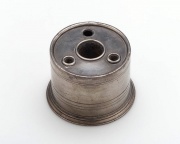Difference between revisions of "Pewter"
| Line 1: | Line 1: | ||
| − | [[File:64.1609-SC60667.jpg|thumb|]] | + | [[File:64.1609-SC60667.jpg|thumb|Pewtwer plate<br>MFA# 64.1609]] |
== Description == | == Description == | ||
| − | + | [[File:64.1871-SC61583.jpg|thumb|Pewter inkwell<br>MFA# 64.1871]] | |
A silvery gray alloy of [[tin]] mixed with another metal, such as [[antimony]], [[copper]], or [[lead]]. Pewter was first product in the 3rd century. Common pewter in antiquity contained 60-80% tin and 40-20% lead while modern pewter contains 65-94% tin, 3-30% copper, 5-10% antimony and/or less than 10% lead, [[zinc]], or [[bismuth]]. The highest grade of pewter contains a large proportion of tin with a small amount of copper. Black metal was the name for a low grade of pewter that contained up to 50% lead mixed with the tin. Pewter was commonly used from the Middle Ages through the mid-19th century for tableware, cups, utensils, and pans. It is still made for specialty items because it is easy to stamp, roll or cast. | A silvery gray alloy of [[tin]] mixed with another metal, such as [[antimony]], [[copper]], or [[lead]]. Pewter was first product in the 3rd century. Common pewter in antiquity contained 60-80% tin and 40-20% lead while modern pewter contains 65-94% tin, 3-30% copper, 5-10% antimony and/or less than 10% lead, [[zinc]], or [[bismuth]]. The highest grade of pewter contains a large proportion of tin with a small amount of copper. Black metal was the name for a low grade of pewter that contained up to 50% lead mixed with the tin. Pewter was commonly used from the Middle Ages through the mid-19th century for tableware, cups, utensils, and pans. It is still made for specialty items because it is easy to stamp, roll or cast. | ||
| − | |||
| − | |||
== Synonyms and Related Terms == | == Synonyms and Related Terms == | ||
| Line 10: | Line 8: | ||
black metal; antique silver; beker (Ned.); étain durci (Fr.); Hartzinn (Deut.); peltro (It.); peltre (Port., Esp.); tenn (Sven.) | black metal; antique silver; beker (Ned.); étain durci (Fr.); Hartzinn (Deut.); peltro (It.); peltre (Port., Esp.); tenn (Sven.) | ||
| − | == | + | == Risks == |
May contain lead. (Darker pewters contain more lead) | May contain lead. (Darker pewters contain more lead) | ||
| − | == | + | ==Resources and Citations== |
* G.S.Brady, ''Materials Handbook'', McGraw-Hill Book Co., New York, 1971 Comment: p. 595 | * G.S.Brady, ''Materials Handbook'', McGraw-Hill Book Co., New York, 1971 Comment: p. 595 | ||
| Line 30: | Line 28: | ||
* ''The American Heritage Dictionary'' or ''Encarta'', via Microsoft Bookshelf 98, Microsoft Corp., 1998 | * ''The American Heritage Dictionary'' or ''Encarta'', via Microsoft Bookshelf 98, Microsoft Corp., 1998 | ||
| − | * Website | + | * Website: Pewter at www.answers.com |
[[Category:Materials database]] | [[Category:Materials database]] | ||
Latest revision as of 10:08, 26 July 2022
Description
A silvery gray alloy of Tin mixed with another metal, such as Antimony, Copper, or Lead. Pewter was first product in the 3rd century. Common pewter in antiquity contained 60-80% tin and 40-20% lead while modern pewter contains 65-94% tin, 3-30% copper, 5-10% antimony and/or less than 10% lead, Zinc, or Bismuth. The highest grade of pewter contains a large proportion of tin with a small amount of copper. Black metal was the name for a low grade of pewter that contained up to 50% lead mixed with the tin. Pewter was commonly used from the Middle Ages through the mid-19th century for tableware, cups, utensils, and pans. It is still made for specialty items because it is easy to stamp, roll or cast.
Synonyms and Related Terms
black metal; antique silver; beker (Ned.); étain durci (Fr.); Hartzinn (Deut.); peltro (It.); peltre (Port., Esp.); tenn (Sven.)
Risks
May contain lead. (Darker pewters contain more lead)
Resources and Citations
- G.S.Brady, Materials Handbook, McGraw-Hill Book Co., New York, 1971 Comment: p. 595
- Ralph Mayer, A Dictionary of Art Terms and Techniques, Harper and Row Publishers, New York, 1969 (also 1945 printing)
- David C. Scott, Metallography and Microstructure of Ancient and Historic Metals, The Getty Conservation Institute, Los Angeles, 1991
- Tom Rowland, Noel Riley, A-Z Guide to Cleaning, Conserving and Repairing Antiques, Constable and Co., Ltd., London, 1981
- Michael McCann, Artist Beware, Watson-Guptill Publications, New York City, 1979
- Random House, Webster's Encyclopedic Unabridged Dictionary of the English Language, Grammercy Book, New York, 1997
- The American Heritage Dictionary or Encarta, via Microsoft Bookshelf 98, Microsoft Corp., 1998
- Website: Pewter at www.answers.com

